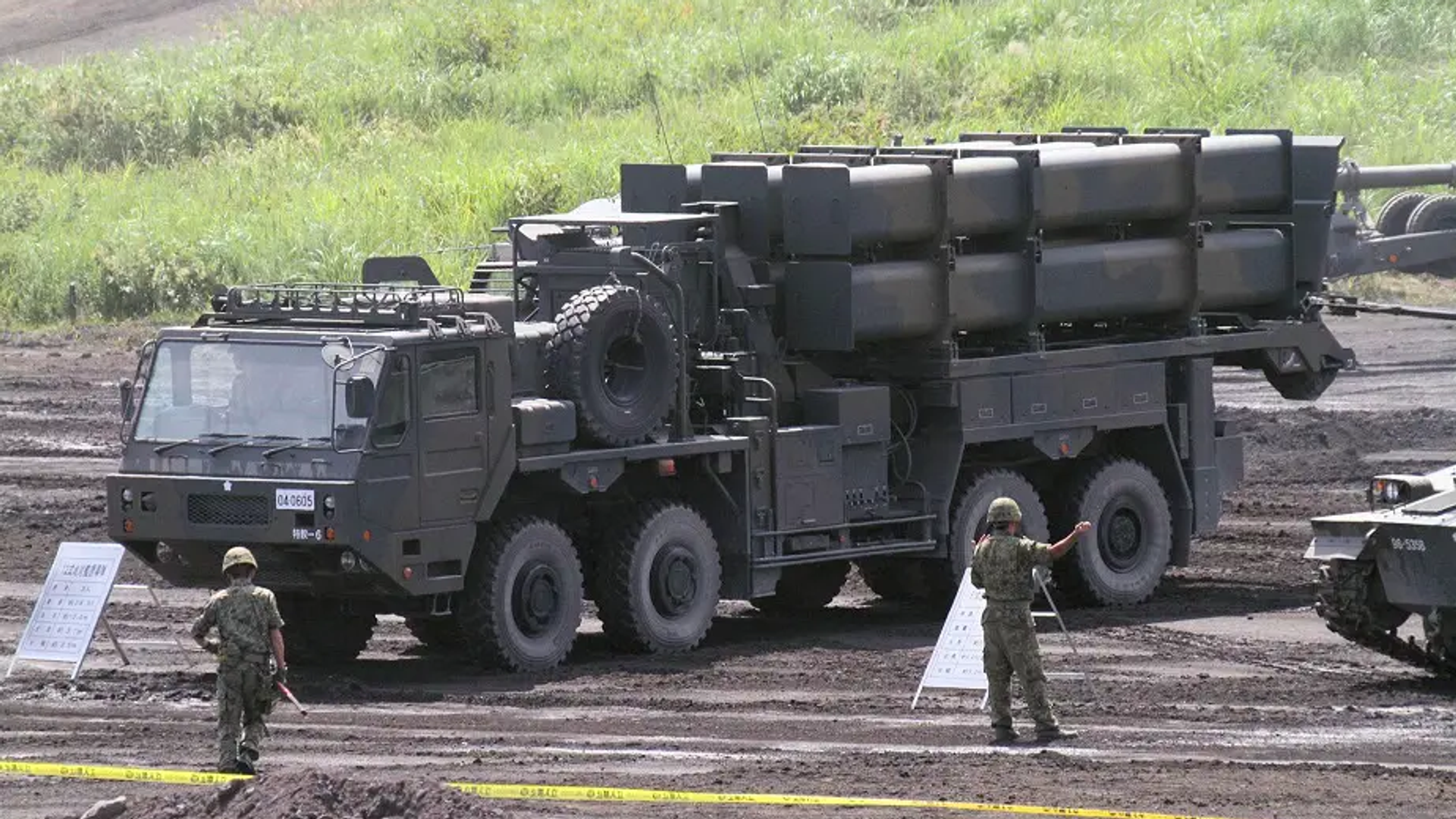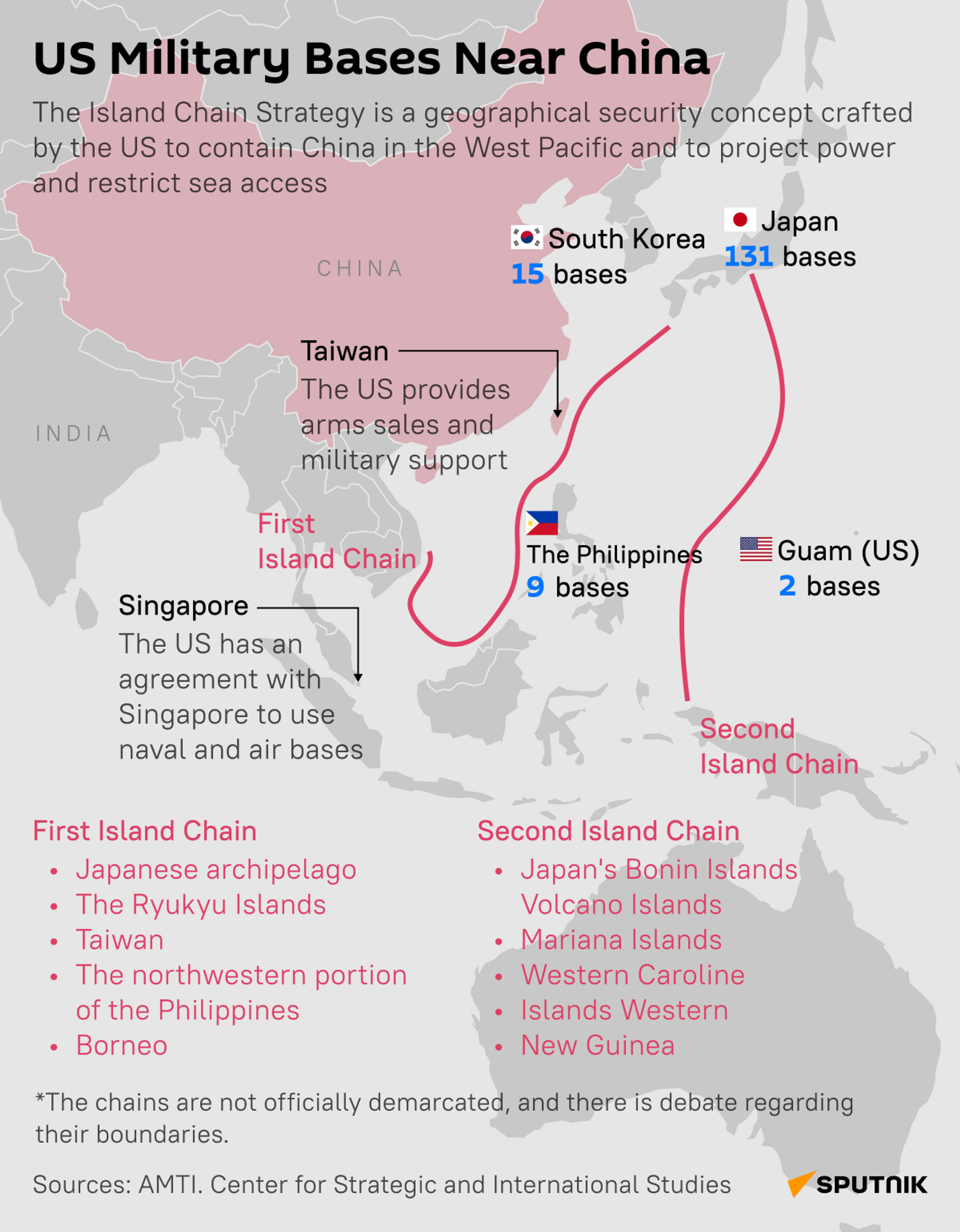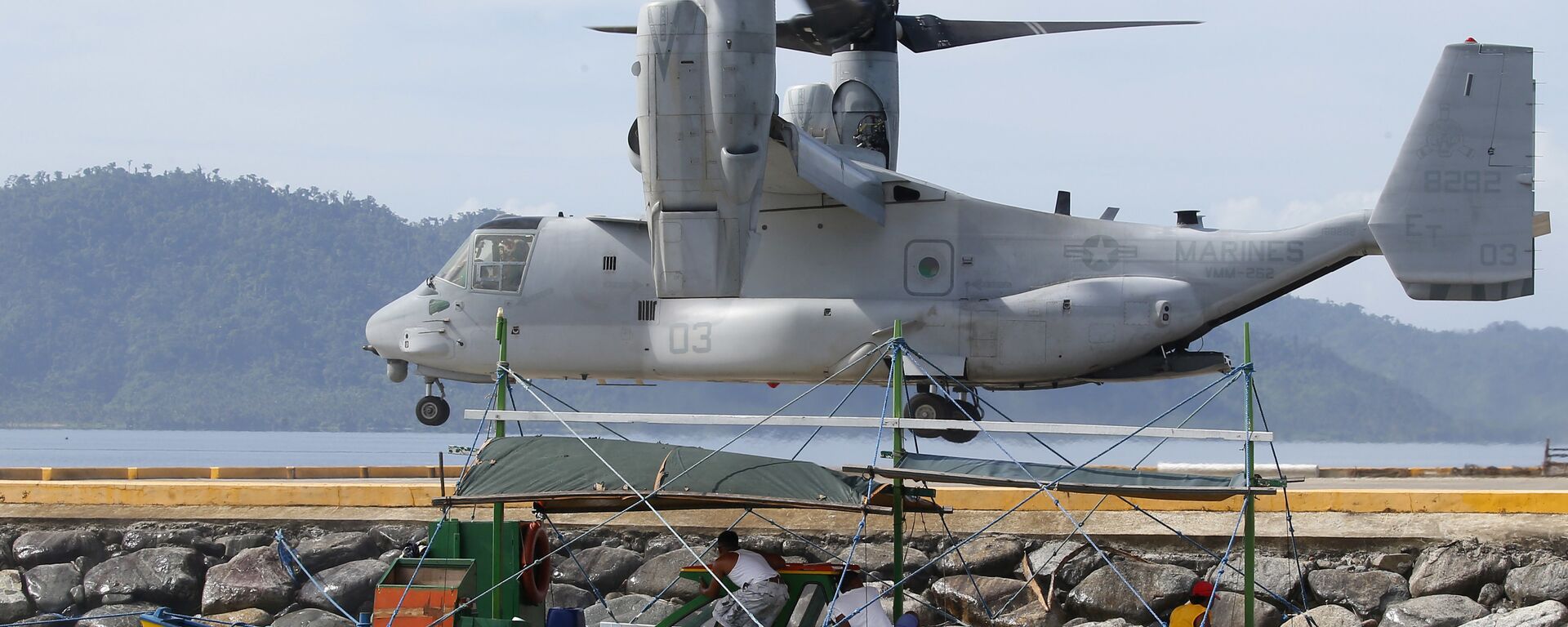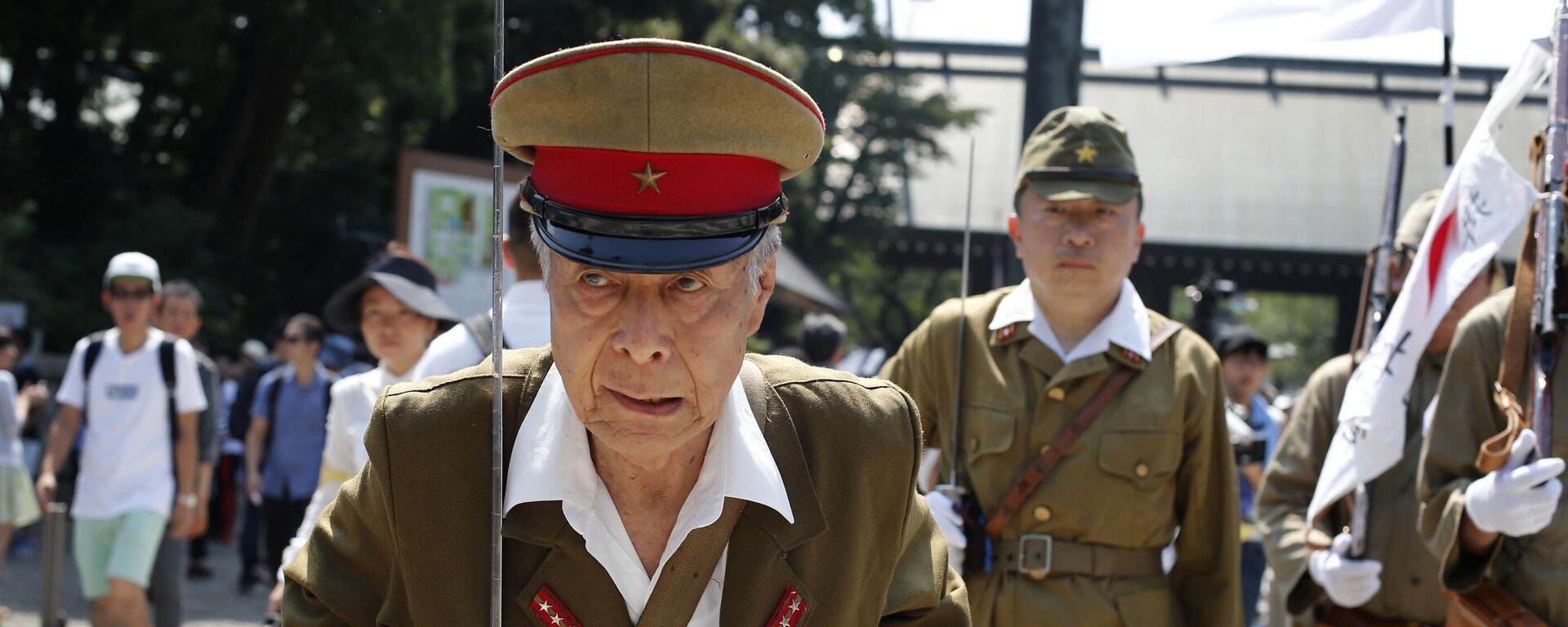https://sputnikglobe.com/20240330/japan-deploys-anti-ship-missiles-in-key-anti-china-chokepoint-of-okinawa-1117662114.html
Japan Deploys Anti-Ship Missiles in Key Anti-China ‘Chokepoint’ of Okinawa
Japan Deploys Anti-Ship Missiles in Key Anti-China ‘Chokepoint’ of Okinawa
Sputnik International
Situated 650 km south of the main Japanese island of Kyushu, Okinawa is home to the largest concentration of US military bases in the Western Pacific, with the prefecture’s 1.45 million residents regularly terrorized by Osprey tilt rotor aircraft flights, falling jet fighter debris, toxic waste dumping and a slew of sexual assaults by US troops.
2024-03-30T16:05+0000
2024-03-30T16:05+0000
2024-03-30T16:05+0000
military
okinawa
japan
china
mitsubishi heavy industries
chinese defense ministry
https://cdn1.img.sputnikglobe.com/img/07e8/03/1e/1117661764_0:48:924:568_1920x0_80_0_0_403acee78cc67c67f085fd526db537a6.png
Japan’s Ground Self-Defense Force held a ceremony in Okinawa on Saturday marking the creation of a new anti-ship missile force at Camp Katsuren, Uruma.Defense Minister Oniki Makoto said the 200 troop-strong unit, armed with Type 12 coastal defense anti-ship missile systems, will be tasked with defending Japan’s southwestern region and even “blocking a possible invasion” by an unnamed foreign adversary.Other Japanese media have made clear that the missile force will be tasked with “keeping watch” over Chinese warships sailing through international waters between Okinawa and Miyako Island (situated about 270 km southwest of Okinawa) to break out into the open sea.Miyako and Ishigaki, another Japanese island located about 400 km southwest of Okinawa, already has similar coastal defense units in place, as does Amami-oshima Island, which is situated about 175 km northeast of Okinawa, and about 330 km southwest of Kyushu Island.Newsweek characterized the Okinawa deployment as a step which will help “counter China’s aggressive moves along the first island chain,” blocking Chinese ships at a vital “choke point.”Built by Mitsubishi Heavy Industries, the Type 12’s 700 kg inertial guidance, GPS and radar-guided missiles have an operational range between 200 and 400 km, with the military industry planning to increase its range to “at least” 1,000 km by 2026 as part of a massive, $320 billion rearmament program announced by Tokyo in 2022.Okinawa Governor Tamaki Denny had previously expressed opposition to the deployment of weapons with counterstrike capabilities in his prefecture, with local authorities and residents engaging in a decades-long struggle against the islands’ militarization, especially by the United States.Pacific's RemilitarizationThe anti-ship missile deployment is part of a regional US-led militarization program targeting the Pacific as part of the Island Chain Strategy. On Friday, a US official and a foreign diplomat told Politico that the US, Japan and the Philippines are planning joint naval patrols in the South China Sea – with an announcement on the matter expected at a summit next month.The US’s aggressive drive has been criticized, both by China itself, and by other regional powers outside of America’s orbit.“The United States continues to strengthen its Asia-Pacific deployments; this is full of a Cold War mindset,” Chinese Defense Ministry spokesman Wu Qian told reporters earlier this month. “The US’ goal is to achieve its own selfish gains and to maintain its hegemony. Its nature is to stoke confrontation.”Earlier, Russian Foreign Ministry spokeswoman Maria Zakharova warned that US activities, including the recent signing of a security pact with Papua New Guinea, “can only be interpreted as another step forward toward militarizing the Asia-Pacific region, escalating military tensions and dragging Port Moresby into Washington’s geopolitical games aimed against Russia and China.”On Saturday, North Korean state media voiced concerns over efforts by Tokyo to “revive” the “departed souls” of the WWII-era Imperial Army, “who embarked on the road of aggression and plunder in the last century,” into a modern-day aggressive force “equipped with ultra-modern military hardware”
https://sputnikglobe.com/20240328/japans-okinawa-prefecture-assembly-lodges-protest-over-osprey-flight-resumption---reports-1117603745.html
https://sputnikglobe.com/20240309/us-gains-military-access-to-three-pacific-nations-as-beijing-berates-confrontational-mindset-1117228217.html
https://sputnikglobe.com/20240305/south-korea-still-seeking-compensation-from-japan-for-world-war-ii-era-atrocities-1117150698.html
okinawa
japan
china
Sputnik International
feedback@sputniknews.com
+74956456601
MIA „Rossiya Segodnya“
2024
News
en_EN
Sputnik International
feedback@sputniknews.com
+74956456601
MIA „Rossiya Segodnya“
Sputnik International
feedback@sputniknews.com
+74956456601
MIA „Rossiya Segodnya“
what is the island chain strategy, who is militarizing the pacific
what is the island chain strategy, who is militarizing the pacific
Japan Deploys Anti-Ship Missiles in Key Anti-China ‘Chokepoint’ of Okinawa
Situated 650 km south of the main Japanese island of Kyushu, Okinawa is home to the largest concentration of US military bases in the Western Pacific, with the prefecture’s 1.45 million residents regularly terrorized by Osprey tilt rotor aircraft flights, falling jet fighter debris, toxic waste dumping and a slew of sexual assaults by US troops.
Japan’s Ground Self-Defense Force held a ceremony in Okinawa on Saturday marking the creation of a new anti-ship missile force at Camp Katsuren, Uruma.
Defense Minister Oniki Makoto
said the 200 troop-strong unit, armed with Type 12 coastal defense anti-ship missile systems, will be tasked with defending Japan’s southwestern region and even “blocking a possible invasion” by an unnamed foreign adversary.
“This is the first time that a surface-to-surface missile unit has been established on the main island of Okinawa, and it is also the first time that Type 12 surface-to-ship missiles have been delivered to the main island,” Japanese newspaper Ryukyu Shimpo reported of the planned deployment earlier in the week.
Other Japanese media
have made clear that the missile force will be tasked with “keeping watch” over Chinese warships sailing through international waters between Okinawa and Miyako Island (situated about 270 km southwest of Okinawa) to break out into the open sea.
Miyako and Ishigaki, another Japanese island located about 400 km southwest of Okinawa, already has similar coastal defense units in place, as does Amami-oshima Island, which is situated about 175 km northeast of Okinawa, and about 330 km southwest of Kyushu Island.
Newsweek
characterized the Okinawa deployment as a step which will help “counter China’s aggressive moves along the first island chain,” blocking Chinese ships at a vital “choke point.”
‘Island chain’ is a reference the plan outlined by US diplomat John Foster Dulles in 1951, known as the Island Chain Strategy, to “contain” China’s navy in its home ports by setting up a string of naval bases, anti-aircraft and anti-ship weaponry in Pacific nations which ring the People’s Republic to prevent the Chinese navy from stretching its sea legs.
Built by Mitsubishi Heavy Industries, the Type 12’s 700 kg inertial guidance, GPS and radar-guided missiles have an operational range between 200 and 400 km, with the military industry planning to increase its range to “at least” 1,000 km by 2026 as part of a massive, $320 billion rearmament program announced by Tokyo in 2022.
Local media say dozens of local residents gathered near Camp Katsuren Saturday to express their opposition to the anti-ship missile unit’s deployment, with some holding placards reading “No to Missiles.” One resident expressed fears that the anti-ship missile base will put civilians in the crosshairs in the event of a conflict.
Okinawa Governor Tamaki Denny had previously expressed opposition to the deployment of weapons with counterstrike capabilities in his prefecture, with
local authorities and residents
engaging in a decades-long struggle against the islands’ militarization, especially by the United States.
Pacific's Remilitarization
The anti-ship missile deployment is part of a regional US-led militarization program targeting the Pacific as part of the Island Chain Strategy. On Friday, a US official and a foreign diplomat told Politico that the US, Japan and the Philippines are planning
joint naval patrols in the South China Sea – with an announcement on the matter expected at a summit next month.
The US’s aggressive drive has been criticized, both by China itself, and by other regional powers outside of America’s orbit.
“The United States continues to strengthen its Asia-Pacific deployments; this is full of a Cold War mindset,” Chinese Defense Ministry spokesman Wu Qian told reporters earlier this month. “The US’ goal is to achieve its own selfish gains and to maintain its hegemony. Its nature is to stoke confrontation.”
Earlier, Russian Foreign Ministry spokeswoman Maria Zakharova warned that US activities, including the recent signing of a security pact with Papua New Guinea, “can only be interpreted as another step forward toward militarizing the Asia-Pacific region, escalating military tensions and dragging Port Moresby into Washington’s geopolitical games aimed against Russia and China.”
On Saturday, North Korean state media
voiced concerns over efforts by Tokyo to “revive” the “departed souls” of the WWII-era Imperial Army, “who embarked on the road of aggression and plunder in the last century,” into a modern-day aggressive force “equipped with ultra-modern military hardware”






